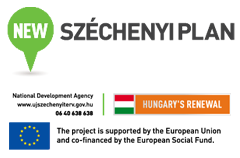Cultural Heritage Research Centre
Based on the motto of INFOTA, we try to deal with partly unsolved problems regarding how to preserve such complex, tangible and intangible heritage elements like:
- buildings and constructions
- artefacts
- books and scriptures
- landscapes
- flora and fauna
- folk art elements and traditions
- music and performing arts
We have been carrying out cultural heritage research activities since 1997. The Centre founded in 2001 gives an umbrella for these activities. The fields of research cover information management, IT support of heritage preservation, monitoring of cultural and natural heritage using remote sensing and direct IT based measuring and data collection technologies, decision support for heritage protection authorities, applying the state-of-the-art IT and knowledge management technologies.
Activities of the Research Centre require co-operation with the members of the World Heritage “movement”. The most important results have been presented at the meetings of UNESCO World Heritage Committee and at other international conferences. The financial background comes from researches, assignments, as well as from EU and national calls.
Our mission includes three principal aims:
- The first is to assess the implementation of the protection of natural and cultural, tangible and intangible heritage worldwide in the last periods of time, the development of appropriate national and international heritage protection legislation and practices; capacity-building at local and regional levels for the management of any heritage sites.
- The second goal is to increase the visibility and the activities carried out to protect heritage and develop new activities for ensuring long-term protection and increasing awareness of heritage preservation.
- Thirdly, opportunities are to be identified to mobilise support for specific action programmes related to heritage conservation, to create synergies between World Heritage stakeholders and to encourage the development of targeted partnerships for site protection and presentation.
All this requires more and more updating from technological points of view. Nowadays, the development is so rapid in these areas that pace has to be kept with them It is such a crucial point that the economic issues of heritage protection is a subject that EU is also considering in different branches of national and international economy. New partnerships are to be set up for the identification, protection, presentation, utilisation of World Heritage sites but in the same time enlarging the scope for those of all tangible and intangible heritage. These procedures involve also non-governmental stakeholders, local and regional authorities, financial institutions, the tourism industry, media, public membership programmes and especially young people – the decision-makers of the future who are to be educated in a proper way about this aspect in order to enable them to take over responsibility.
Nowadays more and more research centres, authorities, civil organizations, councils and private persons are requiring an integrated, centrally maintained but decentralized database, which contains updated information regarding the state of conservation of national cultural and natural heritage sites.
Some important projects:
The monitoring of cultural heritage sites (1997-)
Founding project of the World Heritage Information Management Research Centre becoming the background organisation of IT and information management services covering R&D activities for national and international heritage preservation, digitization, etc. for organizational and authority purposes. (2000-2001)
ICHEPIS — Development of a standardized database model for integrating the UNESCO World Heritage Periodic Reporting System and the National Heritage Preservation Information System (2001-2004)
HEPORT — Development of the Heritage Reporter, a Heritage Preservation Information Delivery System — an internet based, integrated system providing the basic data of heritage elements (sites, items, main value, access, references, etc. if available) as well as supporting facility management and supervision by authorities with strict access for authentications and authorization. (2001-)
Development of a virtual gallery of the Telephony Museum, Hungary (2003-2004)
DSP — Digital Stone Plate project, focusing on the long term storage strategies and methods of digital data for preservation and information retrieval purposes (2004-)
- legal, management and technical aspects of the evolution of paper based document stores into digital ones keeping the full legal value of the documents (2007-)
- architectural, functional and technological specification of the Hungarian National Digital Archives (2008-2009)
Digital Opera House (2005) – a 3D virtual walk within the building, presenting also places not opened to public. (2005)
Network of Rural Heritage Houses – digitisation, archiving, data base construction for a network of more than 300 houses bearing tangible and intangible heritage features (2006-)
Project Works
- Heritage and tourism – applied economic, financial, information and knowledge management researches (2005-)
- Cultural Layers of Hungarian World Heritage Sites – studies covering management issues from culture to economy (2006 – )
- Intangible heritage preservation – dance, music, traditions, (2007-)
- Visitors’ route analysis and virtual exhibition design (2008-)
- Interrelation of heritage, attractions and touristic purposes
- Heritage education – ongoing research project
Audio-visual Heritage Restoration And Digitization Centre (ARRADIC) – a UNESCO project to save early film heritage (2008-2009)
Contribution to saving intangible heritage: Digitisation of several rural farm houses. Hidas, Fertőszéplak, Feertőszentmiklós, Fertőhomok, Györköny
Serb heritage protection project in Deszk (2009):
Restauration management
Collection of materials for digitisation
Mapping of the Old Cemetery
Digitisation (Audio, photo and film materials)
Digitisation of the restored exhibits
Documentation about preservation methodology
Showcase, exhibition arrangements
Publication of information leaflets
Programnavigator – digital program, visit, attraction organiser for hotel guests (2010)
QR Code based audio guide system (2011-)
As touristic development projects result in attraction changes affecting the layers of tourists, the information system for them needs also amendments to stay up-to-date. In the system we have elaborated, information reaches the visitor through a QR code (Quick Response code) that is appropriate for coding nearly all text information and can be used on all printed surfaces being a two dimensional bar code. More
Visit of the natural trail of Sas-hegy by QR code
In the system we established, information is provided to the visitors by QR codes in several languages. The use of QR codes is widely spreading. In our area, a weather resistant plate of the code is attached to the sight that can be a building, plants, natural formations and other views from that given point. The QR code can be read by most cell-phone’s web browsers and iti is also suitable to provide detailed data on the plant, flower, tree as well as to show a complete map of the site and in the same time it can also draw the attention of the visitor on the view points of the trail as from the Sas mountain you have a unique view on several outstanding parts of Budapest. The advantage of the system is that the visitor may return to places, re-read the information or listen to the downloaded pictures, texts or videos.
The complete guide is available (both texts and audio) in Hungarian, English and German. It is also made possible – in order to avoid problems of visitors not having interntet – that at the entrance hall, the visitor downloads the complete guide of the trail.
Video recording of gastronomic heritage (2014)
Central Museum of Mining, Sopron – Multimedia Showcase (2014)
Main co-operation partners have been:
- Graphisoft CAD Studio
- Hungarian Academy of Sciences Centre of Social Sciences
- National Office of Cultural Heritage
- Next Computer Ltd.
- Royal Angkor Foundation
- National Rural Heritage Association
- Urban Heritage Protection Civil Organisation of Budapest
- Forum UNESCO, UNESCO and Heritage
- Europa Nostra
- Best in Heritage (Croatia)
- Green Lines Institute (Portugal)
- Old Town Renewal Agency (Lithuania)
- e-conservation on-line magazine


